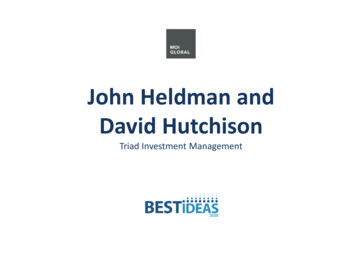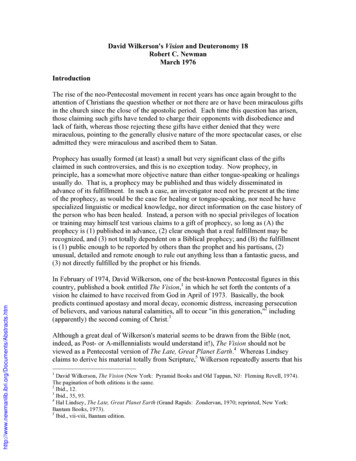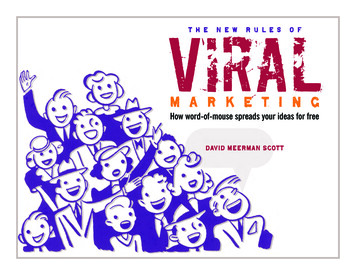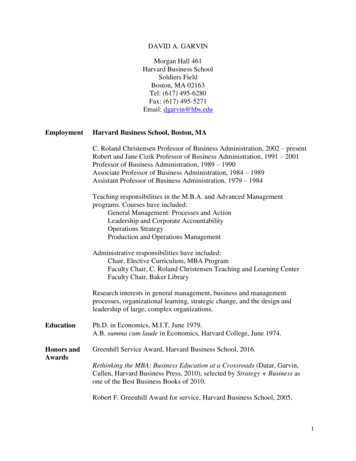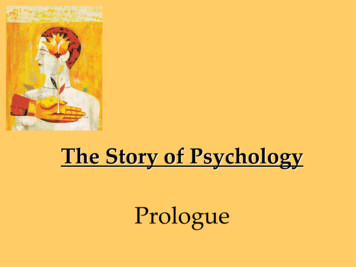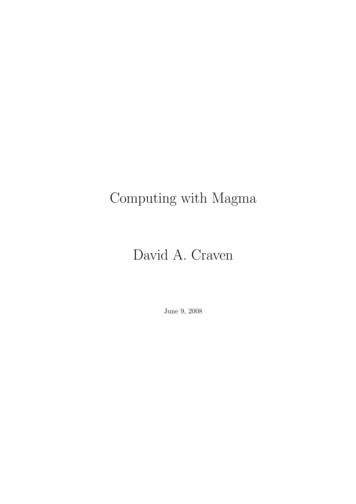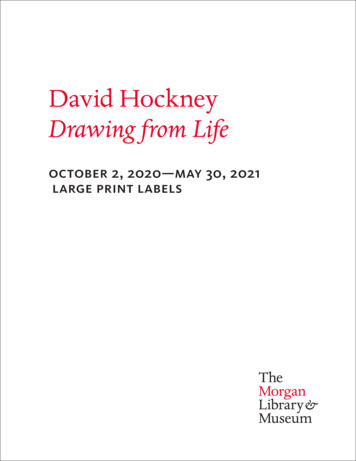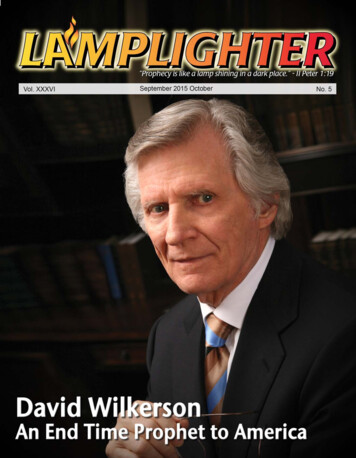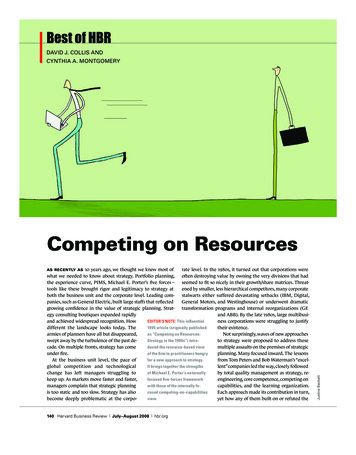
Transcription
Best of HBRDAVID J. COLLIS ANDCYNTHIA A. MONTGOMERYCompeting on Resourcesrate level. In the 1980s, it turned out that corporations were10 years ago, we thought we knew most ofoften destroying value by owning the very divisions that hadwhat we needed to know about strategy. Portfolio planning,seemed to fit so nicely in their growth/share matrices. Threatthe experience curve, PIMS, Michael E. Porter’s five forces –ened by smaller, less hierarchical competitors, many corporatetools like these brought rigor and legitimacy to strategy atstalwarts either suffered devastating setbacks (IBM, Digital,both the business unit and the corporate level. Leading comGeneral Motors, and Westinghouse) or underwent dramaticpanies, such as General Electric, built large staffs that reflectedtransformation programs and internal reorganizations (GEgrowing confidence in the value of strategic planning. Stratand ABB). By the late 1980s, large multibusiegy consulting boutiques expanded rapidlynesscorporations were struggling to justifyand achieved widespread recognition. HowEDITOR’S NOTE: This influentialtheirexistence.different the landscape looks today. The1995 article (originally publishedNotsurprisingly, waves of new approachesarmies of planners have all but disappeared,as “Competing on Resources:tostrategywere proposed to address theseswept away by the turbulence of the past deStrategy in the 1990s”) intromultipleassaultson the premises of strategiccade. On multiple fronts, strategy has comeduced the resource-based viewplanning.Manyfocusedinward. The lessonsunder fire.of the firm to practitioners hungryfromTomPetersandBobWaterman’s “excelAt the business unit level, the pace offor a new approach to strategy.lent”companiesledtheway,closely followedglobal competition and technologicalIt brings together the strengthsbytotalqualitymanagementas strategy, rechange has left managers struggling toof Michael E. Porter’s externallyengineering,corecompetence,competing onkeep up. As markets move faster and faster,focused fi ve-forces anagers complain that strategic planningwith those of the internally foEachapproachmadeitscontributionin turn,is too static and too slow. Strategy has alsocused efutedthebecome deeply problematic at the corpoview.140 Harvard Business Review1320 Collis.indd 140 July–August 2008 Justine BeckettAS RECENTLY AShbr.org6/5/08 7:31:22 PM
Best of HBR Competing on Resourcespreviously accepted wisdom was unclear.The result: Each compounded the confusion about strategy that now besetsmanagers.A framework that has the potentialto cut through much of this confusionis now emerging from the strategy field.The approach is grounded in economics, and it explains how a company’sresources drive its performance in adynamic competitive environment.Hence the umbrella term academicsuse to describe this work: the resourcebased view of the firm (RBV). The RBVcombines the internal analysis of phenomena within companies (a preoccupation of many management gurussince the mid-1980s) with the externalanalysis of the industry and the competitive environment (the central focus ofearlier strategy approaches). Thus theresource-based view builds on, but doesnot replace, the two previous broad approaches to strategy by combining internal and external perspectives.1 It derivesits strength from its ability to explain inclear managerial terms why some competitors are more profitable than others,how to put the idea of core competenceinto practice, and how to develop diversification strategies that make sense. Theresource-based view, therefore, will be aspowerful and as important to strategy inthe 1990s as industry analysis was in the1980s. (See the sidebar “A Brief Historyof Strategy.”)The RBV sees companies as verydifferent collections of physical andintangible assets and capabilities. Notwo companies are alike because notwo companies have had the same setof experiences, acquired the same assetsand skills, or built the same organizational cultures. These assets and capabilities determine how efficiently andeffectively a company performs its functional activities. Following this logic, acompany will be positioned to succeedif it has the best and most appropriatestocks of resources for its business andstrategy.Valuable resources can take a varietyof forms, including some overlooked by142 Harvard Business Review1320 Collis.indd 142 ARTICLE AT A GLANCE What gives your company acompetitive edge? Your strategically valuable resources,which enable you to performactivities better or morecheaply than rivals. These canbe physical assets (a primelocation), intangible assets (astrong brand), or capabilities(a superefficient manufacturing process). Strategically valuableresources have five characteristics: (1) They’re difficultto copy. (2) They depreciateslowly. (3) Your company –not employees, suppliers, orcustomers – controls theirvalue. (4) They can’t be easilysubstituted. (5) They’re superior to similar resources yourcompetitors own.the narrower conceptions of core competence and capabilities. They can be physical, like the wire into your house. Potentially, both the telephone and cablecompanies are in a very strong positionto succeed in the brave new world of interactive multimedia because they ownthe on-ramp to the information superhighway. Or valuable resources may beintangible, such as brand names or technological know-how. The Walt DisneyCompany, for example, holds a uniqueconsumer franchise that makes Disney asuccess in a slew of businesses, from softtoys to theme parks to videos. Similarly,Sharp’s knowledge of flat-panel displaytechnology has enabled it to dominatethe 7 billion worldwide liquid crystaldisplay (LCD) business. Or the valuableresource may be an organizational capability embedded in a company’s routines,processes, and culture. Take, for example,the skills of the Japanese automobilecompanies – first in low-cost, lean manufacturing; next in high-quality production; and then in fast product development. These capabilities, built up overtime, transform otherwise pedestrian orcommodity inputs into superior products and make the companies that havedeveloped them successful in the globalmarket.Competitive advantage, whatever itssource, ultimately can be attributed tothe ownership of a valuable resourcethat enables the company to perform activities better or more cheaply than competitors. Marks & Spencer, for example,possesses a range of resources that demonstrably yield it a competitive advantage in British retailing. (See the exhibit“How Marks & Spencer’s Resources GiveIt Competitive Advantage.”) This is trueboth at the single-business level and atthe corporate level, where the valuableresources might reside in a particularfunction, such as corporate researchand development, or in an asset, suchFOR MORE ON THE RESOURCE-BASED VIEWRaphael Amit andPaul J.H. Schoemaker“Strategic Assets andOrganizational Rent”Strategic Management JournalJanuary 1993J.B. Barney“Strategic Factor Markets:Expectations, Luck andBusiness Strategy”Management ScienceOctober 1986July–August 2008 Kathleen R. Conner“A Historical Comparison ofResource-Based Theory andFive Schools of ThoughtWithin Industrial Organization Economics: Do We Havea New Theory of the Firm?”Journal of ManagementMarch 1991Ingemar Dierickx andKarel Cool“Asset Stock Accumulationand Sustainability of Competitive Advantage”Management ScienceDecember 1989Margaret A. Peteraf“The Cornerstones ofCompetitive Advantage:A Resource-Based View”Strategic Management JournalMarch 1993Richard P. Rumelt“Theory, Strategy, andEntrepreneurship”The Competitive Challenge:Strategies for Industrial Innovation and Renewal, ed. David J.Teece (Ballinger, 1987)Birger Wernerfelt“A Resource-Based Viewof the Firm”Strategic Management JournalApril–June 1984hbr.org6/5/08 7:31:36 PM
ARTICLE IN PRACTICEWhat Makes a Resource Valuable?AppropriabilityScarcityDemandValue creation zoneThe dynamic interplay of three fundamental market forcesdetermines the value of a resource or a capability.offer). Described that way, competingon resources sounds simple. In practice,however, managers often have a hardtime identifying and evaluating theircompanies’ resources objectively. TheRBV can help by bringing discipline tothe often fuzzy and subjective processCompetitively Valuableof assessing valuable resources.ResourcesFor a resource to qualify as the basisResources cannot be evaluated in isolafor an effective strategy, it must pass ation, because their value is determinednumber of external market tests of itsin the interplay with market forces. Avalue. Some are so straightforward thatresource that is valuable in a particularmost managers grasp them intuitivelyindustry or at a particular time mightor even unconsciously. For instance, afail to have the same value in a different industry or chronological context. valuable resource must contribute tothe production of something customFor example, despite several attempts toers want at a price they are willing tobrand lobsters, so far no one has beenpay. Other tests are more subtle and, assuccessful in doing so. A brand namea result, are commonly misunderstoodwas once very important in the personalor misapplied. These often turn out tocomputer industry, but it no longer is, ascause strategies to misfire.IBM has discovered at great cost. Thus1. The test of inimitability: Is thethe RBV inextricably links a company’sresource hard to copy? Inimitabilityinternal capabilities (what it does well)is at the heart of valueand its external induscreation because it limtry environment (whathbr.orgitscompetition. If athe market demandsLearn about companies that areapplying the authors’ advice today atresource is inimitable,and what competitorsas corporate brand identity. Superiorperformance will therefore be based ondeveloping a competitively distinct set ofresources and deploying them in a wellconceived strategy.A resource is strategicallyvaluable if: It is hard to copy. Rivals can’tcopy resources if they’re physicallyunique; for example, a desirable realestate location. It depreciates slowly. Disney’spowerful brand name survived almost two decades of benign neglectbetween Walt Disney’s death in 1966and the installation of Michael D.Eisner in 1984. Your company – not employees, suppliers, or customers – controls its value. For example, yourcompany does not lose critical knowledge when a key employee leaves. It cannot be easily substituted. Because of easy substitution,the steel industry lost a major marketin beer cans to aluminum makers. It is better than competitors’ similar resources. A maker ofmedical-diagnostics test equipmentdesigned an easy interface betweenits machines and people. This designcapability enabled it to expand intodoctors’ offices, where office personnel (not just technicians) could operate its equipment.Continually invest in your strategically valuable resources. Forexample, Eisner revived Disney’scommitment to animation, a keycapability. He invested 50 million inWho Framed Roger Rabbit to createthe company’s first animated featurefilm hit in many years. Disney thenquadrupled its output of animatedfeature films.To stave off inevitable decay invalue, upgrade your resources. Forinstance, diversified manufacturerCooper Industries realized it lackedglobal management capabilities. Itaddressed the problem by acquiringChampion Spark Plug, which hadnumerous overseas plants and couldprovide the skills Cooper needed tomanage international 1320 Collis.indd 143 July–August 2008 Harvard Business Review 1436/5/08 7:31:44 PM
Best of HBR Competing on Resourcesthen any profit stream it generates ismore likely to be sustainable. Possessing a resource that competitors easily can copy generates only temporaryvalue. But because managers fail to apply this test rigorously, they try to baselong-term strategies on resources thatare imitable. IBP, the first meatpackingcompany in the United States to modernize, built a set of assets (automatedplants located in cattle-rearing states)and capabilities (low-cost “disassembly”of beef) that enabled it to earn returnsof 1.3% in the 1970s. By the late 1980s,however, ConAgra and Cargill had replicated these resources, and IBP’s returnsfell to 0.4%.Inimitability doesn’t last forever. Competitors eventually will find ways to copymost valuable resources. But managerscan forestall them – and sustain profitsfor a while – by building their strategiesaround resources that have at least oneof the following four characteristics:The first is physical uniqueness, whichalmost by definition cannot be copied.A wonderful real estate location, mineral rights, or Merck’s pharmaceuticalpatents simply cannot be imitated. Although managers may be tempted tothink that many of their resources fallinto this category, on close inspection,few do.A greater number of resources cannotbe imitated because of what economistscall path dependency. Simply put, theseresources are unique and, therefore,scarce because of all that has happenedalong the path taken in their accumulation. As a result, competitors cannotgo out and buy these resources instantaneously. Instead, they must be builtover time in ways that are difficult toaccelerate.2The Gerber Products brand name forbaby food, for example, is potentiallyimitable. Re-creating Gerber’s brandloyalty, however, would take a very longtime. Even if a competitor spent hundreds of millions of dollars promotingits baby food, it could not buy the trustthat consumers associate with Gerber.That sort of brand connotation can bebuilt only by marketing the productsteadily for years, as Gerber has done.Similarly, crash R&D programs usuallycannot replicate a successful technologywhen research findings cumulate. Having many researchers working in parallel cannot speed the process, becausebottlenecks have to be solved sequentially. All this builds protection for theoriginal resource.A Brief History of StrategyThe field of strategy has largely been shaped around a framework first conceived by Kenneth R. Andrews in his classic bookThe Concept of Corporate Strategy (Richard D. Irwin, 1971).Andrews defined strategy as the match between what a company can do (organizational strengths and weaknesses) withinthe universe of what it might do (environmental opportunitiesand threats).Although the power of Andrews’s framework was recognizedfrom the start, managers were given few insights about how toassess either side of the equation systematically. The first important breakthrough came in Michael E. Porter’s book CompetitiveStrategy: Techniques for Analyzing Industries and Competitors(Free Press, 1980). Porter’s work built on the structure-conductperformance paradigm of industrial-organization economics. Theessence of the model is that the structure of an industry determines the state of competition within that industry and sets thecontext for companies’ conduct – that is, their strategy. Mostimportant, structural forces (which Porter called the fi ve forces)determine the average profitability of the industry and have acorrespondingly strong impact on the profitability of individualcorporate strategies.This analysis put the spotlight on choosing the “right industries” and, within them, the most attractive competitive positions. Although the model did not ignore the characteristics ofindividual companies, the emphasis was clearly on phenomenaat the industry level.144 Harvard Business Review1320 Collis.indd 144 July–August 2008 With the appearance of the concepts of core competence andcompeting on capabilities, the pendulum swung dramaticallyin the other direction, moving from outside to inside the company. These approaches emphasized the importance both of theskills and collective learning embedded in an organization and ofmanagement’s ability to marshal them. This view assumed thatthe roots of competitive advantage were inside the organizationand that the adoption of new strategies was constrained by thecurrent level of the company’s resources. The external environment received little, if any, attention, and what we had learnedabout industries and competitive analysis seemed to disappearfrom our collective psyche. The emerging resource-based viewof the firm helps to bridge these seemingly disparate approachesand to fulfill the promise of Andrews’s framework. Like the capabilities approaches, the resource-based view acknowledges theimportance of company-specific resources and competencies,yet it does so in the context of the competitive environment.The resource-based view shares another important characteristicwith industry analysis: It, too, relies on economic reasoning. Itsees capabilities and resources as the heart of a company’s competitive position, subject to the interplay of three fundamentalmarket forces: demand (does it meet customers’ needs, and is itcompetitively superior?), scarcity (is it imitable or substitutable,and is it durable?), and appropriability (who owns the profits?).The five tests described in the article translate these generaleconomic requirements into specific, actionable terms.hbr.org6/5/08 7:31:49 PM
The third source of inimitability iscausal ambiguity. Would-be competitorsare thwarted because it is impossible todisentangle either what the valuable resource is or how to re-create it. Whatreally is the cause of Rubbermaid’s continued success in plastic products? Wecan draw up lists of possible reasons.We can try, as any number of competitors have, to identify its recipe for innovation. But, in the final analysis, we cannot duplicate Rubbermaid’s success.Causally ambiguous resources areoften organizational capabilities. Theseexist in a complex web of social interactions and may even depend critically onparticular individuals. As Continentaland United try to mimic Southwest’ssuccessful low-cost strategy, what willbe most difficult for them to copy isnot the planes, the routes, or the fastgate turnaround. All of those are readily observable and, in principle, easilyduplicated. However, it will be difficultto reproduce Southwest’s culture of fun,family, frugality, and focus because noone can quite specify exactly what it isor how it arose.The final source of inimitability, economic deterrence, occurs when a company preempts a competitor by makinga sizable investment in an asset. Thecompetitor could replicate the resourcebut, because of limited market potential, chooses not to. This is most likelywhen strategies are built around largecapital investments that are both scalesensitive and specific to a given market.For example, the minimum efficientscale for float-glass plants is so large thatmany markets can support only onesuch facility. Because such assets cannotbe redeployed, they represent a credible commitment to stay and fight it outwith competitors who try to replicatethe investment. Faced with such a threat,potential imitators may choose not toduplicate the resource when the marketis too small to support two players thesize of the incumbent profitably. That isexactly what is now occurring in EasternEurope. As companies rush to modernize, the first to build a float-glass facilityHow Marks & Spencer’s ResourcesGive It Competitive AdvantageTangibleFreehold locations1% occupancy costs versus3% to 9% industry averageBrand reputationCustomer recognition withminimal advertisingNo promotional salesIntangibleLower labor turnoverEmployee loyalty8.7% labor costs versus10% to 20% industry averageSupplier chainLower costs and higher qualityof goods soldManagerial judgmentFewer layers of hierarchyCapabilitiesin a country is likely to go unchallengedby competitors.2. The test of durability: Howquickly does this resource depreciate? The longer lasting a resource is, themore valuable it will be. Like inimitability, this test asks whether the resourcecan sustain competitive advantage overtime. While some industries are stablefor years, managers today recognize thatmost are so
tools like these brought rigor and legitimacy to strategy at . DAVID J. COLLIS AND . medical-diagnostics test equipment designed an easy interface between its machines and people. This design capability enabled
